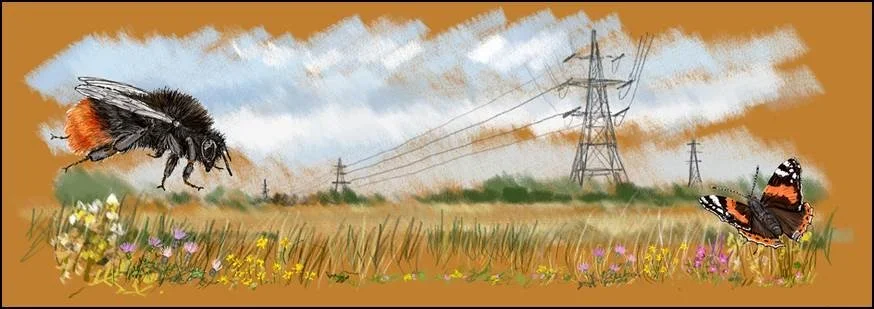Farming practices across Britain radically changed during the 20th century. Pete Strong, one of our History RAT, recounts the effects of two World Wars on the farming community on the Levels.
Agriculture on the Gwent Levels in two World Wars
By the outbreak of the First World War in 1914, Britain was heavily dependent on imported foodstuffs. 80% of grain and 40% of meat was imported, leaving the country vulnerable to blockade by German U-boats.[1] Farmers therefore came under pressure to increase the calorific value of their land by switching from grassland to arable.
In 1915 the government set up War Agricultural Executive Committees (‘War Ags’) in each county to encourage better use of the land and in 1916 ordered farmers to plough up much pasture to plant wheat and potatoes. Farmers were given guaranteed prices for wheat and oats. Even so, farmers on the Levels, which had been almost entirely given over to pasture and hay meadows, were reluctant to change. Arable farming is more labour intensive than grassland and shortage of labour was already a problem, not just because men were leaving to join the army but because they were going to the better paid jobs in the munitions works in Cardiff and Newport. They also argued that the land was not suited to arable farming.
In 1917 Gilbert Mitchell-Innes, agent to the Tredegar Estate and a member of the Monmouthshire ‘War Ag’, told a meeting of farmers in Newport:
There had been a great demand for dairy produce, which was an easier method of farming (than arable) and being human most of them had adopted that method. Then there was hay cutting, which to his mind was not fit to be called farming. These methods had got to be altered now.
He was backed up later in the year by Lord Rhondda himself, who in June had been appointed Minister of Food Control. Speaking to farmers in Magor he said he could find no fault with farmers in Magor itself but that there were others in the county who needed to ‘buck up’.[2]
Attempts to recruit female farm workers were not very successful. Pay of twelve to sixteen shillings for a 48 hour week was only about half that on offer in munitions factories. On top of this many farmers were reluctant to take on females. It wasn’t until 1918 that the Women's Land Army was created, and even then the number of females working on the land remained limited.
In 1918, prisoners-of-war became available. Pencoed Castle near Magor was turned into a prisoner-of-war camp. But it wasn’t all plain sailing. The ‘War Ag’ offered the Commissioners of Sewers forty-eight prisoners to help in the task of ‘casting out’ ditches during the autumn but when work started only twelve men were available.
In spite of all the difficulties, the war had halted the great agricultural depression, for a while at least, and farmers prospered.
In 1921, however, the government ended subsidies for wheat and oat production. This was a body blow to arable farmers and became known as ‘the great betrayal’. The inter-war period saw serious agricultural depression.
Advert for Fordson tractors, Western Mail, 1941.
The Second World War did much to reverse the situation, although it wasn’t a painless process, and in many ways what happened on the Levels during the Second World War was a replay of what had happened during the previous conflict as, once again, farmers were put under heavy pressure to turn to the plough.
In May 1944, Mr Purvis, Chief Executive of Monmouthshire ‘War Ag’, told farmers:
Some two tons of threshed wheat has been raised on an acre of reclaimed land. At least 50 per cent of 23,000 acres of the marshland on the Caldicot and Wentlooge Levels was available for the plough.[3]
This met with a robust response from Mr Watkins, of New House Farm, Whitson:
It is easy to take strangers on to the Moor after three months of drought and convince them that it was the drainage scheme which had dried out the land, but NOT those who lived there and who are on the land every day of the year ...[4]
The shortage of labour was again partly covered by women and prisoners-of-war but once more these did not fully make up for the men lost.
As a result of government support after the war, agriculture avoided the slump of the inter-war years and enjoyed a period of relative prosperity. At present, new challenges have to be faced in the shape of climate change and rising world population. How these issues will change farming on the Levels during the 21st century remains to be seen.
[1] Farmers Weekly, 10 November 2018.
[2] Weekly Argus, 17 November 1917.
[3] Weekly Argus, 13 May 1944.
[4] Weekly Argus, 20 May 1944.
Advert from South Wales Argus, 1918.
Memorial to Lord Rhondda, Minister of Food Control during the First World War, Magor War Memorial (Pete Strong)










![Wesleyan Methodist chapel Castleton (Penny Gregson)[2].jpg](https://images.squarespace-cdn.com/content/v1/5a1d5fb38a02c70db7c34f81/fe4960cd-db68-469d-8411-f5e21327e383/Wesleyan+Methodist+chapel+Castleton+%28Penny+Gregson%29%5B2%5D.jpg)
